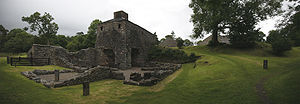
Bonawe
Encyclopedia

Argyll and Bute
Argyll and Bute is both one of 32 unitary council areas; and a Lieutenancy area in Scotland. The administrative centre for the council area is located in Lochgilphead.Argyll and Bute covers the second largest administrative area of any Scottish council...
, Scotland
Scotland
Scotland is a country that is part of the United Kingdom. Occupying the northern third of the island of Great Britain, it shares a border with England to the south and is bounded by the North Sea to the east, the Atlantic Ocean to the north and west, and the North Channel and Irish Sea to the...
opposite Taynuilt
Taynuilt
Taynuilt is a large village in Argyll and Bute, Scotland located at the western entrance to the narrow Pass of Brander.-Location:The village is situated on the River Nant about a kilometre before the river flows into Loch Etive at Airds Bay. This is just to the west of a narrowing of the loch down...
on the north shore of Loch Etive
Loch Etive
Loch Etive is a 30 km sea loch in Argyll and Bute, Scotland. It reaches the sea at Connel, 5 km north of Oban. It measures 31.6 km in length and from 1.2 km to in width...
, most famous for Bonawe Quarry (56°27′05"N 05°13′25"W). Bonawe is primarily a linear settlement along on the B845 road and the coast.
Etymology
The name is derived from Scottish Gaelic Bun Abha, meaning "the mouth of the River AweRiver Awe
The River Awe is a short river in the Southwest Highlands of Scotland by which the freshwater Loch Awe empties into Loch Etive, a sea loch.The river flows from a barrage which stretches across the end of a deep arm of the loch which protrudes northwestward through the Pass of Brander from the...
".
Lorn Furnace
Lorn Furnace or Bonawe Furnace is located across the loch in Taynuilt. It was built in 1753 by Richard Ford & Co. (the Newland CompanyHarrison Ainslie
The firm of Harrison Ainslie & Co. was a British firm of ironmasters and iron ore merchants, selling high quality haematite from their mines on Lindal Moor to smelters in Glasgow, Scotland, South Wales and the Midlands. From a 21st century perspective, they are more interesting as the last...
) from Furness
Furness
Furness is a peninsula in south Cumbria, England. At its widest extent, it is considered to cover the whole of North Lonsdale, that part of the Lonsdale hundred that is an exclave of the historic county of Lancashire, lying to the north of Morecambe Bay....
(now in Cumbria
Cumbria
Cumbria , is a non-metropolitan county in North West England. The county and Cumbria County Council, its local authority, came into existence in 1974 after the passage of the Local Government Act 1972. Cumbria's largest settlement and county town is Carlisle. It consists of six districts, and in...
) to use Furness haematite ore with local charcoal. The same company operated the furnace until 1876. The site is in the guardianship of Historic Scotland
Historic Scotland
Historic Scotland is an executive agency of the Scottish Government, responsible for historic monuments in Scotland.-Role:As its website states:...
.

